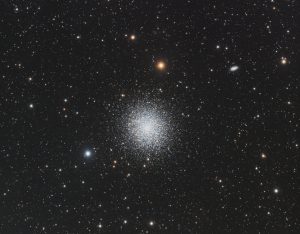There are a couple of majestic globular clusters in the Milky Way as seen from Earth; huge and dense swarms of stars that form a ball (as opposed to open clusters). These including M3 (NGC 5272) and M5 (NGC 5904), but, arguably, M13 is the most impressive. M13 can be see with a naked eye from a very dark spot on a clear moonless summer night. Its individual stars cannot be easily discerned with a low-power telescope, but the cluster itself can be easily observed. It was first discovered by Halley, the comet hunter, in 1714 and later introduced in the Messier catalog. It is some 145 light years wide.
In 1974, the Arecibo observatory decided to send a simple message briefly explaining the Human beings (the Arecibo Message), aimed at possible intelligent recipients residing somewhere inside the Great Globular Cluster M13. The Arecibo Message was a tight beam sent using a powerful radio antenna which could be potentially intercepted by an equally powerful receptor of radio waves, after it reaches the cluster in some 25,000 years. However, in that time, the cluster will move through space and it is unclear if the message will hit it at all. Why sending the message to a cluster? Because the concentration of solar systems located in one place increases the likelihood that there would be some intelligent life residing there.
Data and processing: Goran Petrov
License: Creative Commons BY NC (free for non-commercial use, with attribution).
Click on the image to view full size.
Location: German, Rankovce, Macedonia
Date: 2019-07-01
Total integration time: 3 hours
Camera 1: ATIK One 9.0, cooled to -10C
Telescope 1: Takahashi FSQ 106 ED refractor
Filters:
R, G and B: total 55 x 2 min
L(uminance): 38 x 2 min
Processed in PixInsight.
